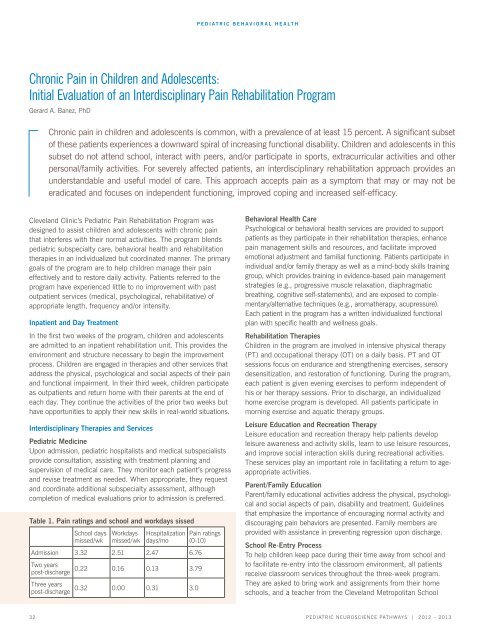Pediatric Neuroscience Pathways Fall 2012 - Cleveland Clinic
Pediatric Neuroscience Pathways Fall 2012 - Cleveland Clinic
Pediatric Neuroscience Pathways Fall 2012 - Cleveland Clinic
Create successful ePaper yourself
Turn your PDF publications into a flip-book with our unique Google optimized e-Paper software.
cleveland clinic’s <strong>Pediatric</strong> Pain rehabilitation Program was<br />
designed to assist children and adolescents with chronic pain<br />
that interferes with their normal activities. the program blends<br />
pediatric subspecialty care, behavioral health and rehabilitation<br />
therapies in an individualized but coordinated manner. the primary<br />
goals of the program are to help children manage their pain<br />
effectively and to restore daily activity. Patients referred to the<br />
program have experienced little to no improvement with past<br />
outpatient services (medical, psychological, rehabilitative) of<br />
appropriate length, frequency and/or intensity.<br />
inpatient and day treatment<br />
In the first two weeks of the program, children and adolescents<br />
are admitted to an inpatient rehabilitation unit. this provides the<br />
environment and structure necessary to begin the improvement<br />
process. children are engaged in therapies and other services that<br />
address the physical, psychological and social aspects of their pain<br />
and functional impairment. In their third week, children participate<br />
as outpatients and return home with their parents at the end of<br />
each day. they continue the activities of the prior two weeks but<br />
have opportunities to apply their new skills in real-world situations.<br />
interdisciplinary therapies and services<br />
<strong>Pediatric</strong> medicine<br />
Upon admission, pediatric hospitalists and medical subspecialists<br />
provide consultation, assisting with treatment planning and<br />
supervision of medical care. they monitor each patient’s progress<br />
and revise treatment as needed. When appropriate, they request<br />
and coordinate additional subspecialty assessment, although<br />
completion of medical evaluations prior to admission is preferred.<br />
<strong>Pediatric</strong> Behavioral health<br />
Chronic Pain in Children and Adolescents:<br />
Initial Evaluation of an Interdisciplinary Pain Rehabilitation Program<br />
Gerard A. Banez, PhD<br />
Chronic pain in children and adolescents is common, with a prevalence of at least 15 percent. A significant subset<br />
of these patients experiences a downward spiral of increasing functional disability. children and adolescents in this<br />
subset do not attend school, interact with peers, and/or participate in sports, extracurricular activities and other<br />
personal/family activities. For severely affected patients, an interdisciplinary rehabilitation approach provides an<br />
understandable and useful model of care. this approach accepts pain as a symptom that may or may not be<br />
eradicated and focuses on independent functioning, improved coping and increased self-efficacy.<br />
table 1. Pain ratings and school and workdays sissed<br />
school days<br />
missed/wk<br />
workdays<br />
missed/wk<br />
hospitalization<br />
days/mo<br />
admission 3.32 2.51 2.47 6.76<br />
two years<br />
post-discharge<br />
three years<br />
post-discharge<br />
0.22 0.16 0.13 3.79<br />
0.32 0.00 0.31 3.0<br />
Pain ratings<br />
(0-10)<br />
Behavioral health care<br />
Psychological or behavioral health services are provided to support<br />
patients as they participate in their rehabilitation therapies, enhance<br />
pain management skills and resources, and facilitate improved<br />
emotional adjustment and familial functioning. Patients participate in<br />
individual and/or family therapy as well as a mind-body skills training<br />
group, which provides training in evidence-based pain management<br />
strategies (e.g., progressive muscle relaxation, diaphragmatic<br />
breathing, cognitive self-statements), and are exposed to complementary/alternative<br />
techniques (e.g., aromatherapy, acupressure).<br />
each patient in the program has a written individualized functional<br />
plan with specific health and wellness goals.<br />
rehabilitation therapies<br />
children in the program are involved in intensive physical therapy<br />
(Pt) and occupational therapy (ot) on a daily basis. Pt and ot<br />
sessions focus on endurance and strengthening exercises, sensory<br />
desensitization, and restoration of functioning. During the program,<br />
each patient is given evening exercises to perform independent of<br />
his or her therapy sessions. Prior to discharge, an individualized<br />
home exercise program is developed. all patients participate in<br />
morning exercise and aquatic therapy groups.<br />
leisure education and recreation therapy<br />
leisure education and recreation therapy help patients develop<br />
leisure awareness and activity skills, learn to use leisure resources,<br />
and improve social interaction skills during recreational activities.<br />
These services play an important role in facilitating a return to ageappropriate<br />
activities.<br />
Parent/family education<br />
Parent/family educational activities address the physical, psychological<br />
and social aspects of pain, disability and treatment. Guidelines<br />
that emphasize the importance of encouraging normal activity and<br />
discouraging pain behaviors are presented. Family members are<br />
provided with assistance in preventing regression upon discharge.<br />
school re-entry Process<br />
to help children keep pace during their time away from school and<br />
to facilitate re-entry into the classroom environment, all patients<br />
receive classroom services throughout the three-week program.<br />
they are asked to bring work and assignments from their home<br />
schools, and a teacher from the <strong>Cleveland</strong> Metropolitan School<br />
32 <strong>Pediatric</strong> NeuroscieNce <strong>Pathways</strong> | <strong>2012</strong> – 2013

















